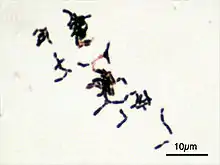Bifidobacteriaceae
The Bifidobacteriaceae are the only family of bacteria in the order Bifidobacteriales.[3] According to the 16S rRNA-based LTP release 106 published by 'The All-Species Living Tree' Project, the order Bifidobacteriales is a clade nested within the suborder Micrococcineae, also the genus Bifidobacterium is paraphyletic to the other genera within the family, i.e. the other genera are nested within Bifidobacterium.
| Bifidobacteriaceae | |
|---|---|
 | |
| Bifidobacterium adolescentis | |
| Scientific classification | |
| Domain: | Bacteria |
| Phylum: | Actinomycetota |
| Class: | Actinomycetia |
| Order: | Bifidobacteriales Stackebrandt et al. 1997[1] |
| Family: | Bifidobacteriaceae Stackebrandt et al. 1997[1] |
| Type genus | |
| Bifidobacterium Orla-Jensen 1924 (Approved Lists 1980) | |
| Genera[2] | |
| |
Genomics
In a phylogenetic tree for the order Bifidobacteriales, based on RpoB, RpoC, and DNA Gyrase B, Gardnerella vaginalis branches between different Bifidobacterium species, which makes the genus Bifidobacterium polyphyletic. The genus could be made monophyletic if G. vaginalis were placed within Bifidobacterium. Comparative analysis of aligned protein sequences has led to the discovery of two conserved signature indels which are specific for the order Bifidobacteriales. The first indel, a 1 amino acid deletion in ribosomal protein L13, is found in all Bifidobacteriales species and no other Actinomycetota, providing a potential molecular marker for the entire Bifidobacteriales order. The second indel that has been identified is a 1 amino acid insertion in glucose-6-phosphate dehydrogenase found in all Bifidobacterium species and G. vaginalis, but not in any other Actinomycetota. This indel is thus characteristic of the clade consisting of Bifidobacterium species and G. vaginalis and can be used to distinguish these genera from the rest of the order Bifidobacteriales. 16 conserved signature proteins have also been identified which are unique to the order Bifidobacteriales and can be used as molecular markers for this order. Additionally, 6 conserved signature proteins which are unique to Bifidobacterium and Gardnerella have been identified, providing further evidence that species from these two genera are closely related and providing molecular markers for the clade consisting of these genera.[4]
Phylogeny
The currently accepted taxonomy is based on the List of Prokaryotic names with Standing in Nomenclature (LPSN).[2] The phylogeny is based on whole-genome analysis.[5][lower-alpha 1]
| |||||||||||||||||||||||||||||||
Notes
- Aeriscardovia, Bombiscardovia, Galliscardovia, Neoscardovia, and Pseudoscardovia are not included in this phylogenetic tree.
References
- Stackebrandt E, Rainey FA, Ward-Rainey NL (1997). "Proposal for a new hierarchic classification system, Actinobacteria classis nov". Int. J. Syst. Bacteriol. 47 (2): 479–491. doi:10.1099/00207713-47-2-479.
- Euzéby JP, Parte AC. "Bifidobacteriaceae". List of Prokaryotic names with Standing in Nomenclature (LPSN). Retrieved June 15, 2021.
- Mantzourani M, Fenlon M, Beighton D (February 2009). "Association between Bifidobacteriaceae and the clinical severity of root caries lesions". Oral Microbiol. Immunol. 24 (1): 32–7. doi:10.1111/j.1399-302X.2008.00470.x. PMID 19121067.
- Gao, B.; Gupta, R. S. (2012). "Phylogenetic Framework and Molecular Signatures for the Main Clades of the Phylum Actinobacteria". Microbiology and Molecular Biology Reviews. 76 (1): 66–112. doi:10.1128/MMBR.05011-11. PMC 3294427. PMID 22390973.
- Nouioui I, Carro L, García-López M, Meier-Kolthoff JP, Woyke T, Kyrpides NC, Pukall R, Klenk HP, Goodfellow M, Markus Göker M (2018). "Genome-Based Taxonomic Classification of the Phylum Actinobacteria". Front. Microbiol. 9: 2007. doi:10.3389/fmicb.2018.02007. PMC 6113628. PMID 30186281.
External links
- Systema Naturae 2000 / Classification - Family Bifidobacteriaceae Archived 2007-09-29 at the Wayback Machine